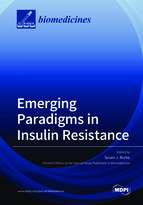Emerging Paradigms in Insulin Resistance
A special issue of Biomedicines (ISSN 2227-9059). This special issue belongs to the section "Cell Biology and Pathology".
Deadline for manuscript submissions: closed (30 November 2021) | Viewed by 42368
Special Issue Editor
Interests: lipid metabolism; insulin resistance; inflammation; obesity; beta-cell dysfunction
Special Issues, Collections and Topics in MDPI journals
Special Issue Information
Dear Colleagues,
Insulin resistance is defined as defective insulin action in its target tissues. There are many discrete routes to the onset of peripheral insulin resistance, e.g., obesity, chronic glucocorticoid excess, lipodystrophy, etc.; therefore, much remains to be determined regarding the underlying pathology of insulin resistance and tissue specific mechanisms.
This Special Issue of Biomedicines is entitled “Emerging Paradigms in Insulin Resistance”. The topics covered in the Special Issue include but are not limited to original research articles that identify novel pathways and factors involved in the development of insulin resistance, emerging technological advances or tools in the study of insulin resistance, and novel genetic models developed to study insulin resistance and associated metabolic pathologies. We also invite the submission of review articles that provide a comprehensive overview of recent innovative advances in studying insulin resistance and its consequent metabolic alterations.
Dr. Susan J. Burke
Guest Editor
Manuscript Submission Information
Manuscripts should be submitted online at www.mdpi.com by registering and logging in to this website. Once you are registered, click here to go to the submission form. Manuscripts can be submitted until the deadline. All submissions that pass pre-check are peer-reviewed. Accepted papers will be published continuously in the journal (as soon as accepted) and will be listed together on the special issue website. Research articles, review articles as well as short communications are invited. For planned papers, a title and short abstract (about 100 words) can be sent to the Editorial Office for announcement on this website.
Submitted manuscripts should not have been published previously, nor be under consideration for publication elsewhere (except conference proceedings papers). All manuscripts are thoroughly refereed through a single-blind peer-review process. A guide for authors and other relevant information for submission of manuscripts is available on the Instructions for Authors page. Biomedicines is an international peer-reviewed open access monthly journal published by MDPI.
Please visit the Instructions for Authors page before submitting a manuscript. The Article Processing Charge (APC) for publication in this open access journal is 2600 CHF (Swiss Francs). Submitted papers should be well formatted and use good English. Authors may use MDPI's English editing service prior to publication or during author revisions.
Keywords
- insulin resistance
- obesity
- metabolic disease
- genetic models
- technological advances
- ‘omics’ datasets
- signaling pathways
- biomarkers







